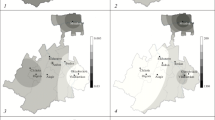Abstract
A survey is given of a number of investigations indicating the importance in natural selection of the genetical environment of populations and individuals.
In the introduction it is observed that blood group frequency patterns are very stable, even in very small populations, and appear independent of environmental factors. They appear to be race-specific, maintained by a process of natural selection which is dependent of the racial genetical composition. Indications in favour of this hypothesis are obtained from several studies carried out in populations of mixed origin:
The introduction on a small scale into the populations of New Guinea of foreign elements with some S genes may result in a population with relatively high S frequencies; the frequencies of certain of the blood group genes in the mixed negroid populations of Curaçao are not in agreement with the racial compositions of the mixtures as they have been calculated from the frequencies of other blood group genes, and the same appears to be the case in the populations of the Himalayas. The marked variation of MNSsHe frequencies in Africa may perhaps be explained by a powerful selective pressure exercized by the genetical backgrounds of the various populations, as is demonstrated by the absence of some expected genotypes among male Bush Negroes in Surinam.
The effects of natural selection by genetical environment can also be demonstrated by family studies:
In families with elliptocytosis Rhesus segregation shows some deviation from Mendelian laws, and the ratio of elliptocytosis-positive and-negative children appears to depend on the Rh genotype of the elliptocytosis-positive parent. From blood group studies in selected pedigrees and dizygotic twins it appears that twin pairs are more often doubly concordant for both MN and Rh than is to be expected.
Some implications of the observed effects of natural selection in the study of human genetics and population dynamics are briefly discussed.
Similar content being viewed by others
References
Cheeseman, E. A., C. M. Crozier &J. D. Merret (1956). Data on linkage in man; hereditary deafness in North Ireland.Ann. hum. Genet. 21: 59–60.
Geerdink, R. A. (1964). Elliptocytosis hereditaria, Een genetisch en hematologisch onderzoek. Thesis, Utrecht.
Mourant, A. E. (1954). The distribution of the human blood groups. Blackwell Scientific Publications, Oxford.
Nijenhuis, L. E. (1961a). Some aspects of blood groups and natural selection. Proc. 2nd Int. Congr. Hum. Genet., Rome, vol. 2: 903–906.
Nijenhuis, L. E. (1961b). Blood group frequencies in the Netherlands, Curaçao, Surinam and New Guinea; a study in population genetics. Thesis, Amsterdam. Publication of the Central Laboratory of the Netherlands Red Cross Blood Transfusion Service, Amsterdam.
Nijenhuis, L. E. (1961c). Blood group frequencies in the Upper Digul and Muyu districts and in the Star Mountains of Netherlands New Guinea. Nova Guinea, 1961, 1–14.
Nijenhuis, L. E. (1961d). Investigation of blood groups as a key to the relationship of Papuans.Trop. geogr. Med. 13: 267–272.
Nijenhuis, L. E. (1963a). Blood group frequencies and haemoglobin types in Tibetans and Nepalese.Vox Sang. 8: 622–626.
Nijenhuis, L. E. (1963b). Deviations from the Mendelian laws in human families. The action of natural selection on blood groups in twins. Proc. XI Int. Congr. of Genetics, the Hauge, vol. 1: 279 (abstract).
Nijenhuis, L. E., A. C. van der Gugten, H. den Butter &J. W. Doeland (1965). Blood group frequencies in northern West New Guinea (West Irian).Am. J. hum. Genet. 17: 69–79.
Nijenhuis, L. & Jeltje Gemser-Runia (1965). Hereditary and acquired blood factors in the negroid population of Surinam. III Blood group studies.Trop. geogr. Med., in press.
Simmons, R. T., J. J. Graydon, N. M. Semple &C. D. N. Taylor (1951). Blood, taste and secretion; A genetical survey in Maoris.Med. J. Aust. 1: 425–431.
Stevenson, A. C. &E. A. Cheeseman (1954). Muscular dystrophy in Northern Ireland. III Linkage data with particular reference to autosomal limb girdle muscular dystrophy.Ann. hum. Genet. 19: 165–173.
Author information
Authors and Affiliations
Rights and permissions
About this article
Cite this article
Nijenhuis, L.E. Blood groups and natural selection by genetical environment. Genetica 36, 208–228 (1965). https://doi.org/10.1007/BF01557154
Received:
Issue Date:
DOI: https://doi.org/10.1007/BF01557154




